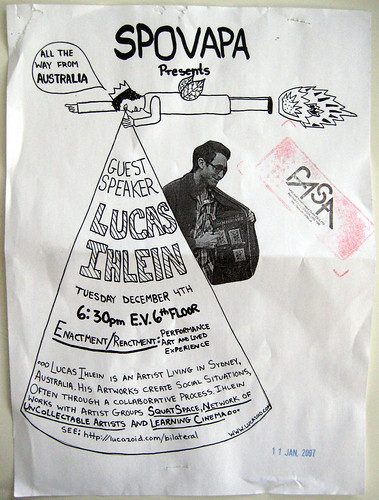On the way back from Montreal, we spent a few days in Brooklyn, nosing around there and Manhattan… two highlights:
Anthony McCall's film installation Doubling Back (2003) at the Whitney Museum.
Rumour has it that the recent resurgence in interest in McCall's films of the 1970s [especially Line Describing a Cone] has prompted him to get back into the game. Line Describing a Cone. is like no other film – during its 30 minute duration, a single point of light grows, inch by inch, to form a circle on the screen. The screen, however, aint where the action is – the room, filled with fog, becomes a container for a massive sculptural object – a cone of light – and an audience is free to roam, and play with the shell of light as it curves over your head. The piece is marvellous as a reductive structuralist film – literally, all you have is light and duration, and McCall makes you aware of the travelling path of the light beam – but it's also a great participatory experience, and very liberating, once you get over the inhibition to play that's been programmed in as a natural part of film and art-viewing practice.
Where Doubling Back goes beyond and above Line Describing a Cone, is in its infinitite loop-ness. While the earlier piece had a definite beginning and end, and a fixed audience, the newer one plays continuously, and visitors can casually enter and exit the gallery space. [in this case, the film was screened all day, every Sunday, as part of the Whitney Biennale]…In that dark room, I lost all sense of time – I think I watched the piece all the way through twice, but I couldn't be sure…
In addition, the shapes in Doubling Back are far more complex than the simple cone – two curved lines intersect each other, each moving almost imperceptibly slowly, constantly changing their curvatures. Concentrate on the movement, and you don't see it – look away for a few minutes, and you'll notice the change. The curved lines at times scoop under your knees, sometimes forming very a very tight leaf-like shape, and at other times they open right out, soaring above and around your head. Standing in the middle of these shapes, and gazing back towards the projector, I felt curiously disembodied – like my eyes, in my head, were my only sensory organs. But when I walked back out of the conoid shape, the light caressed my skin and I could palpably feel its tickle like the surface tension of a liquid.
Doubling Back was a delightful, subtle experience, in the midst of an exhibition [the Whitney Biennial] otherwise too chock-full of bitsy art and gossiping visitors.
[ps… you can see a page on McCall at the Whitney Museum's website, but I can't link to it directly – you will have to go to it [http://www.whitney.org/biennial/] and select "Explore Biennial Artists" in their stupid Macromedia Flash web pages…] … better still, have a look at a pic of Doubling Back here: http://www.artnet.com/artwork/424029518/_Anthony_McCall_Doubling_Back.html
Vito Acconci archive at Barbara Gladstone Gallery
Acconci is a legendary New Yorker whose artistic output [performances, videos, texts, photographs] between 1969 and 1973 was enormous. It seems evident from his work in this period that he was working some heavy shit out, personally – especially in his private relationships. In one work he would obsessively follow a stranger in the street, in another he masturbated under a temporary floor, apparently fantasising about the gallery visitors walking above him. He tried to stuff all of his partners long hair into his mouth, and thus get closer to "consuming" her; and in one durational piece, he waited each night at the end of an abandoned pier for lone visitors, to whom he would tell a [presumably damaging] secret. In many of his works Acconci used the formulae established for "conceptual" art-making to push the limits of his own psyche, to go beyond the "normal" and the "comfortable, especially with regards to daily behaviour.
With his work of the early 1970s I never get the idea that Acconci is simply "making art" or playing out hollow gestures for philosophical or intellectual pleasures. His work is moving and personally challenging, even at a distance of 30 (!) years.
In this show in New York, hundreds of type-written "scores" for performances and activities are presented, alongside photographs and video, where available, of the processes/outcomes. Plenty of the scores, it seems, were never realised, or else were self-sufficient and required no documentation.
One of my favourite pieces [which also I saw recently at the ICA in London] is a video in which Acconci, circa 1972, presents a slide show of some of his work from the previous years. There are two levels of "disclosure" in the slideshow. In the first, the artist, his back to us, selects a slide and points to aspects within it, explaining very simply and logically what he was attempting to achieve. Every so often, however, he gets up, walks to the wall on which the slide is projected, and turns sideways, whispering, as if to somebody just off camera, a woman who he is obviously close to. And he says things like "…but only you, only you would know what this piece was really about, only you know what happened between us that July, when she came and began living with us, and the tension, the jealousy was thick in the house…" and so on. What I found moving about this work was the need, the tangible need to disclose, everything, and so to avoid letting "Art" take over, for the work to become merely an "art-work". The risk is clear – Acconci's art activities could (and did?) change his life.
[links: Barbara Gladstone Gallery, Acconci Studios]
